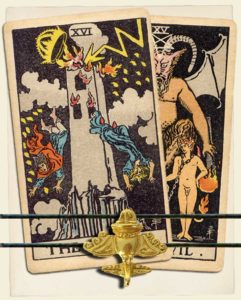Brendan Simms continues in the third chapter of his book:
From mid November 1919, Hitler mounted a series of full-scale attacks in public speeches on the main enemy—‘absolute enemies England and America’. It was Britain which had been determined to prevent Germany’s rise to world power, in order not to jeopardize their ‘world monopoly’. ‘That was also the reason,’ Hitler claimed, ‘to make war on us. And now America. As a money country it had to intervene in the war in order not to lose the money they had lent.’ Here he explicitly made the link between his anti-capitalistic critique and the hostile behaviour of the western coalition. This was closely connected to Hitler’s anti-Semitism. ‘The Americans put business above all else. Money is money even if it is soaked in blood. The wallet is the holiest thing for the Jew,’ he claimed, adding: ‘America would have stuck with or without U-boats.’ What is remarkable here is that the terms ‘the Americans’ and ‘the Jews’ were used almost interchangeably.
As I said earlier, a small faction of the American racial right, represented by Francis Parker Yockey (1917-1960) and the retired Michael O’Meara (1946 – ) were, like Hitler, harsh critics of Anglo-American capitalism.
Anyone wishing to be introduced to Yockey’s thought can do so by reading Kerry Bolton’s essay, ‘A Contemporary Assessment of Yockey’, pages 47-70 of this PDF I compiled.
Anyone wishing to be introduced to O’Meara’s thought can do so by reading my excerpts from his Toward the White Republic here.
 O’Meara’s Toward the White Republic was the first book published by Counter-Currents. In yesterday’s post I discussed ‘White Nationalism is Not Anti-Semitism’: an article by O’Meara that should have been included in Toward the White Republic (the first page of the hard copy I own contains a few words the author wrote to me). Greg Johnson delayed the publication of the short article ‘White Nationalism is Not Anti-Semitism’, whereas O’Meara wrote it in 2010 and Johnson published that piece in October 2011.
O’Meara’s Toward the White Republic was the first book published by Counter-Currents. In yesterday’s post I discussed ‘White Nationalism is Not Anti-Semitism’: an article by O’Meara that should have been included in Toward the White Republic (the first page of the hard copy I own contains a few words the author wrote to me). Greg Johnson delayed the publication of the short article ‘White Nationalism is Not Anti-Semitism’, whereas O’Meara wrote it in 2010 and Johnson published that piece in October 2011.
O’Meara always wrote very clearly, concisely and didactically, which I cannot say of Yockey, although Bolton’s essay linked above summarises Yockey’s philosophy admirably. But even if a visitor reads carefully the summaries of these two intellectuals linked above, he still won’t have arrived at the Christian Question that Hitler himself would, years later, understand. Even more than Mammon worship, the CQ has been the real poison for ethno-suicidal whites. For example, although the Chinese have become Mammon worshipers, by not submitting to Christian ethics they haven’t become ethno-suicidal like the white madmen, who import millions of coloureds. But let’s take it one step at a time. Simms continues:
If Hitler’s profound hostility to the Anglo-Saxon powers was shaped by his anti-Semitism, it was also distinct and, crucially, anterior to it. He had, after all, spent almost the entire war fighting the ‘English’, and latterly the United States. Hitler became an enemy of the British—and also of the Americans—before he became an enemy of the Jews. Indeed, he became an enemy of the Jews largely because of his hostility to the Anglo-American capitalist powers. Hitler could not have been clearer: ‘We struggle against the Jew,’ he announced at a public meeting in early January 1920, ‘because he prevents the struggle against capitalism.’
The rest of Germany’s adversaries, by contrast, fell into a second and milder category. The Russians and the French, so the argument ran, had become hostile ‘as a result of their unfortunate situation or some other circumstances’. Hitler was by no means blind to the extent of French antagonism, but it is striking that he discoursed at much greater length about the financial terms of the treaty, and the blockade, than the territorial losses to Germany’s immediate neighbours. This focus on Anglo-American, and increasingly on US, strength, with or without anti-Semitism, was by no means unusual in Germany, or even Europe generally. It reflected a much broader post-war preoccupation with the immense global power of the United States. As we shall see, Hitler’s entire thinking, and the policies of the Third Reich after 1933, were in essence a reaction to it.
Remember the words by the Canadian Ronin in my post yesterday: ‘The betrayal of the White European race stems from deep, deep within, so deep that it is not visible or obvious for most’. That’s something the white nationalists south of Canada still don’t want to see! These are the words of Greg Johnson, Michael O’Meara’s editor a dozen years ago, in the thread discussing O’Meara’s article that white nationalism, as O’Meara understood it, is not simply a synonym of anti-Semitism:
I think that O’Meara has a chip on his shoulder and is spoiling for a fight with people who are essentially on his side. I don’t see any good that can come from that.
This, of course, is to misunderstand the whole thing, as O’Meara wasn’t trying to unnecessarily provoke the Counter-Currents commentariat. What he was trying to convey is that there are more serious causal factors in white decline than Jewish subversion, and that consequently our horizon shouldn’t be limited to the JQ.
Johnson’s words quoted above are from 2011. What American white nationalists still don’t want to see, we will see in this extensive review of Simms’ revisionist biography of Hitler.







